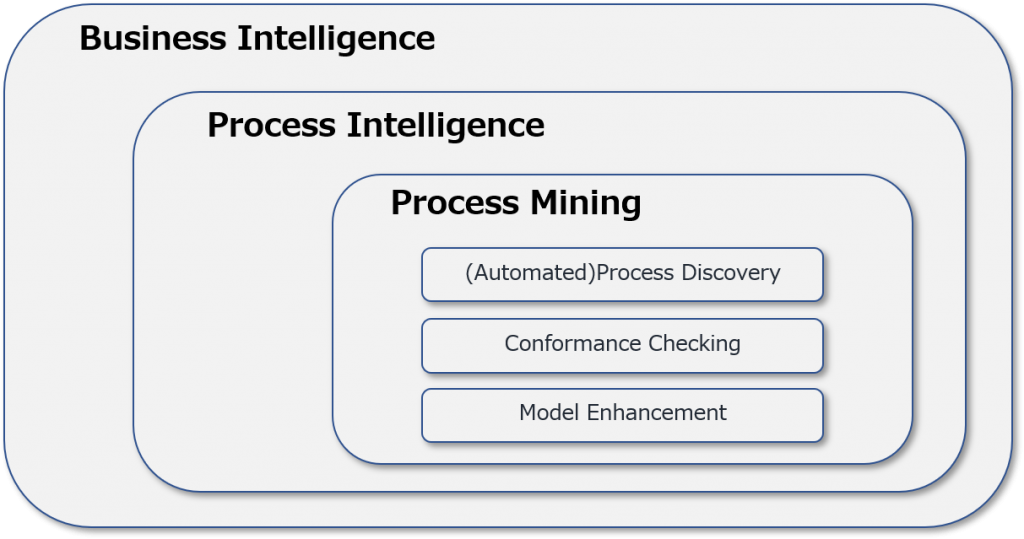Process Mining vs Process Intelligence
English follows Japanese. Before proofread.
プロセスマイニングについて書かれた資料やベンダー情報では、「プロセスインテリジェンス」という言葉がしばしば登場します。
「プロセスインテリジェンス」がどのようなものか、ベンダーによってその定義は異なるようですが、明確な説明がないため、プロセスマイニングとどう違うのか混乱されている方も多いと思われます。
当記事では、「プロセスマイニング」と「プロセスインテリジェンス」の関係性や違いについて、「ビジネスインテリジェンス」も含め、わかりやすさを優先して解説したいと思います。
実のところ、両者の関係性は明白で、2011年に発行された「プロセスマイニングマニフェスト」に以下の図が掲載されています。
ご覧の通り、一番大きな枠として「ビジネスインテリジェンス」があり、その内側に「プロセスインテリジェンス」、さらにその内側に「プロセスマイニング」があるという入れ子構造になっています。
まずビジネスインテリジェンスですが、文字通り、ビジネスに関わるあらゆるデータ・情報を分析対象として収集し、分析するものです。いわゆるBIツールを用いて分析することが多いですが、典型的には、売上や利益などの財務データをベースに、年度別、月別、週別などの推移を見たり、エリア別や製品別にドリルダウンして、売上や利益に貢献しているエリアや製品カテゴリ、逆に足を引っ張っている要因がどこかを掘り下げて分析する。これがビジネスインテリジェンスです。
ビジネスインテリジェンスのうち、特に業務プロセスに関わるデータ・情報に絞って各種分析を行うのが「プロセスインテリジェンス」です。さらに、プロセスインテリジェンスの中で、業務の流れ、すなわち「コントロールフロー」を核とする分析手法が「プロセスマイニング」です。
このようにみると、プロセスマイニングは大きくはビジネスインテリジェンスに含まれるため、ビジネスインテリジェンスで代替できるのではないか、とおっしゃる方もいます。
しかし、プロセスマイニングの基本機能である「(自動的な)プロセス発見」には、特殊なアルゴリズムが必要であり、BIツールには、このアルゴリズムは通常、実装されていません。また、BI機能に基づいて、プロセスマイニング用のアルゴリズムをゼロベースで組むのは現実的には不可能です。(初歩的なものは組めたとしても、それによって、再現されたプロセスモデルの信頼性は低いものでしょう)
したがって、プロセスマイニングを実行したければ、専用のプロセスマイニングツールの採用が必要になり、BIで代替することはできません。
では、プロセスインテリジェンスがカバーする領域はどこになるのでしょうか?
プロセスマイニングツールでは、特殊なアルゴリズムを用いて行うプロセス発見以外に、様々な統計数値を算出し、様々な表・グラフで表現する機能が備わっています。
例えば、分析対象としたプロセスに含まれる案件数、プロセスの開始から終了までのスループット(サイクルタイム)や、各アクティビティごとの処理数、処理時間、あるアクティビティから別のアクティビティまでの移行時間、すなわち待ち時間などです。そして、これらの数値に関して平均、最大・最小、中央値、標準偏差などを併せて確認することが可能です。
こうした統計数値の算出は、シンプルな四則演算ベースで可能であり、特殊なアルゴリズムは言うまでもなく必要ありません。BIでも簡単に実行できますが、これこそ「プロセスインテリジェンス」がカバーしている領域です。
プロセスマイニングによる分析においては、アルゴリズムを通じて発見された「プロセスモデル」(as isプロセスモデル)を起点に、様々なバリエーションを検証する「バリアント分析」や、理想プロセス(to beプロセス)との比較分析、すなわち適合性検査などを行います。
さらに、処理時間がKPIを超えている問題アクティビティや、待ち時間が長くなっているボトルネックを特定していきますが、ここで重要になってくるのが処理件数や処理時間、待ち時間などの基本統計数値です。
すなわち、プロセスマイニングでは、プロセスモデルと併せてプロセスインテリジェンスの数値を様々な視点で掘り下げることを行うわけです。
主要なプロセスマイニングツールでは、プロセスモデルを作成するアルゴリズムは当然として、プロセスインテリジェンス機能、特に、様々な数値をビジュアルに表現するダッシュボード機能が標準で装備されています。この意味では、現在のプロセスマイニングツールは、「プロセスインテリジェンスツール」と言い換えても全く支障がないと言えます。
The term “Process Intelligence” is often used in process mining documentation and vendor information.
The definition of “Process Intelligence” varies from vendor to vendor, but there is no clear definition, therefere many people are confused about how it differs from process mining.
In this article, I would like to explain the relationship and differences between “process mining” and “Process Intelligence”, explaining “Business Intelligence” at the same time.
In fact, the relationship between the two is clear, as illustrated in the “process mining manifest” published in 2011.
As you can see, the largest frame is the “Business Intelligence”, inside which is the “Process Intelligence”, and inside which is the “process mining”. They are nesting relationships.
Business intelligence is literally the collection and analysis of all the business related data and information. The analysis is often conducted using so-called BI tools, typically starting from financial data such as sales and profits, we look at trends by fiscal year, month, and week, and drill down by area and product to delve into the areas and product categories that contribute to sales and profits, as well as the factors that are hindering them. This is business intelligence.
“Process Intelligence” is a type of business intelligence analysis that focuses on data and information related to business processes. Furthermore, “process mining” is an analytical method based on the flow of business process, or “Control Flow” in process intelligence.
Some people say that since process mining is basically included in business intelligence, can it be replaced by business intelligence?
However, the basic function of process mining, “(automatic) Process Discovery” requires a special algorithm that BI tools typically do not equipped with. And it is not practical to build algorithms for process mining based on BI capabilities from scratch (Even if you could build an elementary one, the process model that you reproduced would be unreliable.)
Therefore, if you want to do process mining, you need to use a dedicated process mining tool, which BI cannot replace.
So where does process intelligence cover?
In addition to process discovery using special algorithms, the Process Mining Tool calculates various statistical values and presents them in various tables and graphs.
For example, the number of issues involved in the process being analyzed, the throughput from start to finish of the process (cycle time), the number of activities per activity, the processing time, the transition time (path time) from one activity to another, or the wait time. The average, maximum and minimum, median, and standard deviation of these values can also be checked.
These statistics can be calculated on the basis of simple arithmetic operations without the need for special algorithms. It’s easy to do with BI. That’s where “Process Intelligence” covers.
In the process mining analysis, based on the “process model” (as is process model) discovered through the algorithm, various variations are verified “variant analysis”, and comparative analysis with ideal processes (to be Process), that is, conformance checking, is performed.
In addition, identify problem activities where processing time exceeds KPIs and bottlenecks where waiting time is too long. Basic statistics such as number of processes, processing time, and waiting time are important.
In other words, process mining involves drilling down into process intelligence figures from various perspectives in conjunction with process models.
The major process mining tools have standard process intelligence capabilities with dashboards that visually represent various numbers, as well as algorithms for creating process models. In this sense, it is safe to say that the current process mining tools are “process intelligence tool”.


